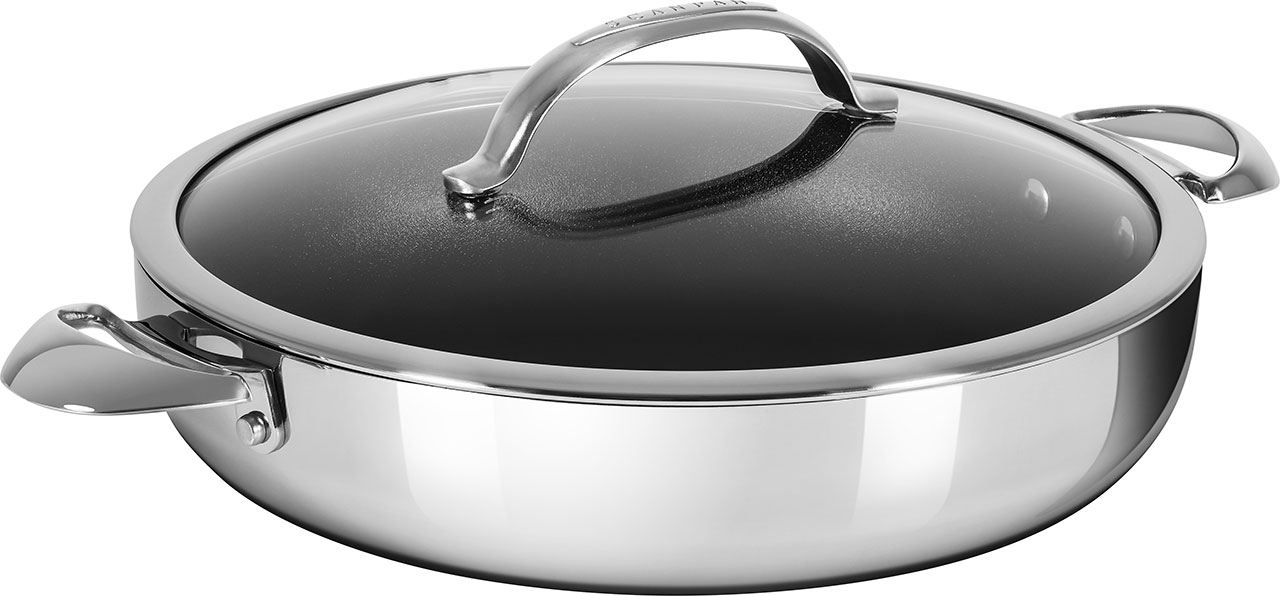Australians young and old are increasingly worried about the safety of non-stick cookware. In all likelihood, you’ve heard rumours that Teflon can cause cancer.
Is there any truth to those rumours? And is there a better type of non-stick pan that you can safely rely on? The answer to both questions is yes. So let’s look a bit at the science of non-stick coatings and what brands like Scanpan are doing to make it safer and more reliable.
Scanpan’s nonstick products contain PTFE which is included in the large group of PFAS substances. In cookware, these substances lend durability and superior nonstick properties and are completely bound in the hardened coating, so they will not transfer to food or the environment during use.

The Science Behind Non-Stick Pans and Cancer
There are two main causes of concern for Teflon: PFOA, and overheating. PFOA is a chemical used in the creation of teflon pots and pans (as well as in many other household products). It’s been widely used for decades, but in recent years, there has been speculation among top scientists that it may cause cancer and other health problems.
Now DuPont, the company behind Teflon, points out that PFOA is only used in the process of binding the non-stick coating to pots and pans. They claim that none of the chemical is left over after this binding process. Still, in any case, scientists and governments around the world are working to phase out PFOA.
The good news for consumers is that many non-stick pans made today proudly bear the “PFOA Free” label.
What About Heating Non-Stick Pans?
This is the second major concern and applies to a much wider variety of non-stick pans from all brands. Most consumers simply aren’t aware that their non-stick pots and pans are only designed to operate up to a specific temperature, usually around 250°C. Anything beyond that and problems begin to occur.
As the non-stick coating begins to break down, a cocktail of chemicals is released. But are you at risk when using your pan normally? In the previously mentioned study, the Australian Consumers Association found that:
“Its true that chemicals such as trifluoroacetic acid (TFA) can be given off by some coatings at extremely high temperatures. But its unlikely to happen during normal cooking…Research hasnt indicated harmful long-term effects of TFA on people. At this stage theres no evidence that non-stick cooking poses a safety risk.”
Still, if you’re using your pan on high heat, it’s possible that some hot spots may exceed safe temperatures. To be safe, it’s best to avoid using non-stick cookware for cooking which involves very high temperatures (you should be using stainless steel or cast iron to sear your steaks or brown your chicken). But for the everyday jobs we use our non-stick pans for most frequently, like cooking eggs or sautéing vegetables, it shouldn’t pose any health problems.
The Truth About Non-Stick Pans: Ceramic vs. Teflon
FAQ
Is SCANPAN really non toxic?
What is SCANPAN coating made of?
What is the least toxic cookware?
Does Scanpan use Teflon?
Now known to professional and home chefs as one of the world’s best nonstick cookware manufacturers, Scanpan limits their use of Teflon in Stratanium—a proprietary blend of titanium, ceramic, and PFOA-free Teflon, resulting in the highest durability on the market.
Is Scanpan PTFE?
Our detailed ScanPan review will answer your questions about all the ScanPan lines. ScanPan is high quality nonstick cookware made in an environmentally conscious factory out of 100% recycled aluminum. It still has many of the environmental issues of PTFE cookware, but it’s better than most.
Is Scanpan a nonstick coating?
Unlike other nonstick coatings like PTFE (Teflon), Scanpan‘s ceramic titanium surface is exceptionally scratch resistant. In standardized tests, Scanpan scored a 9 on the Mohs hardness scale, compared to Teflon at 2-3 ( ). This superior durability also makes it safe to use metal utensils without damaging the nonstick finish.
Does Scanpan have a scratch resistant surface?
Scanpan is a premium Danish brand that pioneered the use of a ceramic titanium coating for nonstick cookware. This patented surface consists of a layer of ceramic reinforced with titanium particles bonded to the pan ( ). Unlike other nonstick coatings like PTFE (Teflon), Scanpan‘s ceramic titanium surface is exceptionally scratch resistant.
